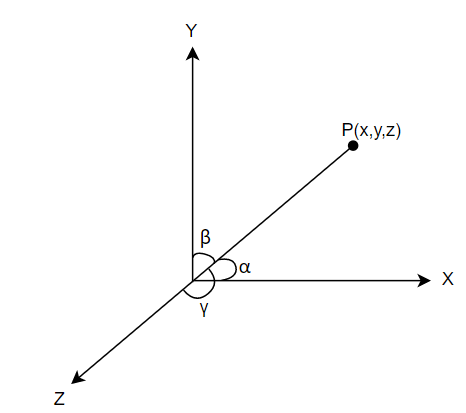Question
Question: The cartesian equation of a line is \(6x-2=3y+2=2z-2\). Find its direction ratios and also find the ...
The cartesian equation of a line is 6x−2=3y+2=2z−2. Find its direction ratios and also find the vector equation of the line.
Solution
Hint: First of all, express the given line in the form of standard line, that is, mx−a=ny−b=pz−c. Now for this line, (m,n,p) are its direction ratios. Also, the vector equation of a line is given as r→=ai+bj+ck+λ(mi+nj+pk).
Complete step-by-step answer:
We are given a cartesian equation of a line as 6x−2=3y+2=2z−2. We have to find its direction and the vector equation of the line. Before proceeding with the question, let us loot at what vector ratios mean. When a directed line OP passing through the origin makes α,β and γ angles with x,y and z axis respectively with 0 as reference, then these angles are referred to as the direction angles of line and cosine of these angles give us the direction cosines. These direction cosines are usually represented as l,m and n. Now, when these direction cosines are multiplied by a particular number, then the new ratios (a,b,c) are called as direction ratios of line.

Now, let us consider our question. We are given the cartesian equation of a line as, 6x−2=3y+2=2z−2. We know that for the line of a standard form mx−a=ny−b=pz−c, the line passes through (a,b,c) and its direction ratios are (m,n,p). So, first, let us convert the given line in this form.
6x−2=3y+2=2z−2
By taking out 6,3,2, which are the common from the first, second and third term of the above equation respectively, we get,
6(x−62)=3(y+32)=2(z−22)⇒6(x−31)=3(y−(3−2))=2(z−1)
By dividing by 6 in the above equation, we get,
66(x−31)=63(y−(3−2))=62(z−1)⇒1(x−31)=2y−(3−2)=3(z−1)
Now, as we have expressed our line in standard form mx−a=ny−b=pz−c, we get,
direction ratios of given line =(m,n,p)=(1,2,3). Line passes through the points =(a,b,c)=(31,3−2,1). Now, we know that if a line passes through points (a,b,c) and its direction ratios are (m,n,p), then its vector equation is given by, r→=ai+bj+ck+λ(mi+nj+pk)
By substituting a=31,b=3−2,c=1 and m=1,n=2,p=3 in the above equation, we get the vector equation of the given line as, r→=31i−32j+k+λ(i+2j+3k).
Hence, we get the direction ratios of the given line as (1,2,3) and the vector equation as, r→=31i−32j+k+λ(i+2j+3k).
Note: In this question, many students make mistake while converting the given line to the standard form, that is mx−a=ny−b=pz−c. So be careful while taking out the common terms and putting the signs in the numbers. It is always better to convert the given line into a standard form of line other than remembering multiple formulas to calculate the direction ratios, etc.
